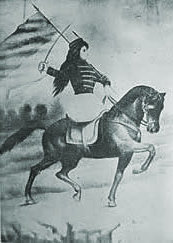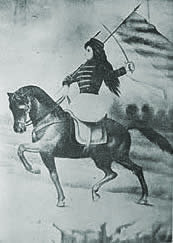
|
Women and Independence in Latin America An exploration of women's involvement in the Latin American Wars of Independence |

|

|
Women and Independence in Latin America An exploration of women's involvement in the Latin American Wars of Independence |

|
Click on one of the images below to see the full-size image
 Antonia Santos |
 Antonia Santos |
Gender:Female
Ethnic origen: Unknown
Events:
| 1782? | - | Charalá | - | Not applicable | - | She was born here. |
| 1785? | - | Charalá | - | Not applicable | - | Monsalve gives her year of birth as 1785. |
| 1819 | - | Coromoro | - | Unknown | - | Her home, El Hatillo, Coromoro, was a centre for local guerillas. |
| 1819 | - | Socorro | - | Unknown | - | She was executed (shot) in Socorro on 28 July 1819. |
Connections:
female relatives of executed patriotsBiography:
She was born in 1782 in Charalá (Colombia?) and became a martyr of independence when she was shot in 1819 (in Socorro, Santander, Colombia) for spying on the Spaniards. (Pallis, 20-21.) She is the "mujer patriota" of Socorro province. (Hincapie Borda, 155)
Her home, El Hatillo, Coromoro, was a centre for the guerrillas of Coromoro. Her brother was one of the leaders of this group. She helped the guerrillas by providing supplies, directing counter-attacks and encouraging others to join them. She was condemned to death on 28 July 1819. Ten days after her execution, freedom was announced in Boyocá. (Knaster, 474, 491, 492.)
Arciniegas describes her as having paid with her life (in Charalá) for the republican cause. (Arciniegas, 86)
Hincapie Borda claims that as she went to her execution, she defiantly asked the troops to shoot directly at her heart. And she told one of the servants who accompanied her that if any part of her body was exposed after her death, it should be covered up immediately. (Hincapie Borda, 156)
Her relative, Miguel Gómez Plata, was executed by Morillo on 28 November 1816. (Monsalve, 174)
Born in Charalá, Socorro province, in 1785, the daughter of Pedro Santos and María Plata. She was tall and elegant, with large brown eyes and long eyelashes, thick lips, aquiline nose and thick, curly hair. There is nothing said about her action in 1810 during the outbreak of independence, nor during Morillo's occupation. She appears in 1819 during the "terror" when she helped to organise guerrilla operations at the family mansion, El Hatillo, to support Bolívar's troops as they tried to cross the Andes. Others involved were her brother, Fernando Santos, her nephew Ramón Santos, Antonio Tobar, Vicente and José Ardila, Gabriel Uribe, and others, around 40 in all. They met and were given provisions at El Hatillo, where they received information and the necessary resources. Forced donations demanded by the royalists ruined some families and increased support for the patriots as did the violent campaigns. In July 1819, Bolívar was approaching across the Andes from Casanare, a guerrilla band was at Los Arraynes, close to El Hatillo, and another was in Tunja province. Captain Pedro Agustín Vargas arrived at El Hatillo and found Antonia Santos there with her 15 year old niece, Elena Santos, they and two slaves, Juan and Juana were arrested and taken to Charalá on foot and imprisoned with two patriot prisoners, Pascual del Espíritusanto Becerra and Isidro Bravo, who had gone to El Hatillo for food and clothing. Juan Sámano was informed of their capture and he announced Antonia Santos, Isidro Bravo, Pascual Becerra and the two slaves, would be shot as enemies of the King "as a lesson to the evil ones". The sentence was pronounced on 16 July, the day on which Bolívar reached Tunja province. They were executed at 10.30 on 28 July 1819 in Socorro Plaza. Her brother, Santiago Santos stayed with her until her final moments. She was dressed in a black suit with short sleeves, with a black shawl over her head, her hair was loose, making her pale face white. She wore some jewellery, including an emerald ring that she had had since a child. She walked serenely and with dignity between two lines of guards, repeating the words of her priest in a low voice. She stood before the tearful, angry crowd, took off her earrings and gold brooch, and gave them and her will to her brother, asking him to be brave and resigned. She gave her emerald ring to the official in command of the guard so that they would shoot cleanly at her heart and not her face or limbs causing unnecessary pain. She commanding officer put his hands behind his back, a blindfold was put on Antonia Santos and the guards fired. Becerra and Bravo were also executed, there is no mention of the slaves Juan and Juana who refused to denounce Santos in official documents. Monsalve maintains that they were executed at the same time according to witnesses. The priest Sarafín de Candete buried Antonia Santos, Pascual Becerra and Isidro Bravo in Socorro cemetery on 28 July 1819. After her death, the inhabitants of Socorro rose up in protest, armed with sticks, knives, machetes, etc to avenge Santos's death. Royalist Coronel González was obliged to retire to his quarters in Oíba for his own security. (Monsalve, 198-205).
She was executed on 28 July 1819 in Socorro. (P. Forero, 46)
Related to María Leonor Gómez and Ignacia Gómez Plata? Related to Nicomedes Plata? Related to Petronila and Salomé Plata? Related to María Norberta Santos?
References:
Arciniegas, Germán (1961) América mágica: II Las mujeres y las horas
Forero, Paulo E. (1972) Las heroinas olvidadas de la independencia
Hincapie Borda, Alicia (2000) Tras la imagen y la presencia de Policarpa
Knaster, Meri (1977) Women in Spanish America: An Annotated Bibliography from Pre-Conquest to Contemporary Times
Monsalve, José D (1926) Mujeres de la independencia
Pallis, Michael (trans.) (1980) Slaves of Slaves: The Challenge of Latin American Women